
Wine Culture and Information since 2002 - Volume 22
 Wine Culture and Information since 2002 - Volume 22 |
|
Issue 38, February 2006 |
Contents |
|
|
The Taste of Wine |
|
In the beginning, they were sweet, dense and syrupy, so that they were diluted with water before drinking. Later, came out dry ones as well as lively ones with cheerful effervescence. Then, the happy bubbles became famous and considered as noble, becoming a fashion and sign of high class. In their beginning, they were sweet, then dry. Therefore, after having overcome a period of less interest, it was the time of barrique - or better, a way to use the barrique - and the fashion of being similar to wood at all costs, a fashion which today tends to become less and less popular, but that still has its followers. The taste of wine changes. As it occurs in the nature of the development of habits and fashions concerning human beings, the same is for wine which - against its will - follows this rule, too. If in ancient times, wine has to have a sweet taste to be good - sometimes a little sour as well - today this rule does not have the same kind of approval. Likewise, it is also true that - being highly probable - the wines produced at the time of ancient Greeks and Romans, would not satisfy our taste at all. The contrary - of course - is also true as well: it is pretty hard ancient Greeks and Romans could share the enthusiasm we have today for dry wines - with a full body and complexity - with evident hints of wood. Times, fashions and tastes change. And time, which inexorably goes by, will introduce - for sure - new tastes and new fashions in the world of wine. Should we have a crystal ball, we could predict the future of the taste of wine, but frankly, we prefer the idea of waiting and see this new “surprise”. After all, who could ever bet - 30 years ago - that in later times would become famous and appreciated wines with strong organoleptic qualities of wood? If we look back in time, trying to remember the facts of those periods, the first pioneers, who tried to introduce barrique in the vinification process, were banned - in a sense - from the world of enology, as they were considered crazy and even responsible for a cultural massacre against wine. But if we see how things are today, these figures are today considered the fathers of the new and modern enology, taken as reference and model for their wines and - although most of them are still alive - they also conquered a place of honor in the history of enology. Whether they were also responsible for imposing a certain taste of wine among consumers, it is pretty difficult to say as well as being not very sustainable. Responsible for the introduction of a new fashion in wine it is more likely probable, but - after all - consumers are the ones who determine the success or the failure of a fashion. Commercial and speculative factors certainly play a fundamental role, but in case fashion should be mostly based on these presuppositions, it would disappear in a short time. Anyway, the taste of wines with wood flavors is still alive and frequently looked for by consumers, a sign that it is not only a matter of fashion, but also a matter of having met - like to say - the taste of our times. Defining the taste of wine is something hard to explain, especially for the fact that wine represents something absolutely personal to everyone and with which everyone have a personal relationship. Saying the taste of wine - or anyway the wine, in every aspect and for everything it may mean - must have specific qualities in order to be good, it is something that belongs more to presumption and arrogance than to reality. For many people, a good wine could be white and pretty crisp, for others it could be, on the contrary, red and robust. Anyway, there are certain reference models with which it is possible to form a specific image of the taste of wine, which can be objectively considered as good by most of consumers, in other words, a wine statistically good. Producers are of course aware of these statistics and on them they widely base the taste and the style of their wines. However, statistics cannot guarantee a stable success, because consumers - obeying to the nature of human beings - continuously change their tastes and preferences. An example for all is the so “loved-hated” barrique, precious enological tool which - since always or at least in the last years - has been subject of many arguments, both good and bad. Some years ago, barrique was in fact seen as an essential tool for the production of high quality wines. Today, instead, many producers tend to use it less and less, getting back to the use of large casks. A trend confirmed also from what the consumers express about their taste and there are many who believe producers make today an excessive use of barrique in their wines. Paradoxically, some years ago, many consumers would have preferred producers to use the barrique more. It will be the abuse of barrique - exasperated also from trendy and commercial factors - to change the opinion of consumers. Today, they say the organoleptic qualities of barrique influence too much on the taste of wine. Probably, this is also the sign the taste of wine is changing again and today the trend is to prefer a wine expressing the qualities of grapes instead. There are more and more people who have a preference for wines, also being robust and complex, but substantially offering aromas and tastes of flowers and fruits, both to the nose and to the palate. Is the era of wines with wood nuances over? Of course not, also because wood has been and it will be a factor of primary importance in the production of many wines. Although it is difficult to predict, it could happen in the next years that wines, uniquely made in inert containers - such as steel tanks - can conquer a dominant position in consumers' preferences and tastes. What we can tell today about the taste of wine - by considering the opinions of consumers - is that there are many to prefer crisp and fruity white wines and robust and complex red wines, in which barrique, or in any case wood, is not excessively intrusive. This seems to be the new direction taken from producers, certainly in their interest, but - obviously - in the interest of our taste, too.
|
||||
MailBox |
|
In this column are published our reader's mail. If you have any comment or any
question or just want to express your opinion about wine, send your letters to
our editorial or fill in
the form available at
our site.
|
| I was very curious about sparkling wine production and in the pages of your publication, I have found the answers I was looking for about this subject. Many compliments. However, there is a point I do not still understand: if we start from a base wine of 10-12%, the alcohol which develops during refermentation, does not increase the volume of the wine? It is impossible the work of yeast is only about the production of carbon dioxide without producing any alcohol. Thank you for your reply. |
| Davide Mazzoli -- Rimini (Italy) |
| Dear Reader, first of all, we would like to thank you for your appreciation about DiWineTaste: we are happy to know in the pages of our publication, you could satisfy your curiosity about sparkling wine production. As you have rightly observed, during the refermentation in bottle, the yeast does not produce carbon dioxide only. Technically speaking, carbon dioxide is a byproduct of the fermentation of sugar, and the main product being the alcohol. During the refermentation in bottle, both dioxide carbon and alcohol are being produced, the latter contributing to increase the alcohol volume of the wine. Base wines, used for the production of sparkling wines, have very special organoleptic and chemical qualities, including a high acidity and a lower alcohol volume than regular table wines. In general terms, at the end of the refermentation in bottle, alcohol volume of the wine increases in the measure of 1.2-1.3%, therefore compensating the lack of the base wine and then reaching the typical volumes of most of table wines. |
| What is the difference between raisin wine and sweet wine? |
| Arthur Martins -- Seattle, Washington (USA) |
| Sweet wines represent a generic category to which belong all sweet wines having the organoleptic quality of sweetness and produced according to different enological techniques. Raisin wines - belonging to the category of sweet wines - are produced with dried grapes only. The withering of the grapes can be done naturally, by leaving the clusters on the vine, or leaving the clusters - after harvesting - in sufficiently aerated rooms. In both cases, grapes lose considerable quantities of water, concentrating - at the same time - the quantity of sugar, which gives the wines their typical sweetness. The lesser quantity of water allows the production of wines with a fuller body and more consistency than those produced with fresh grapes. Raisin wines - in France known as Vin de Paille and mainly produced in Jura - are typically produced in almost every region of Italy, by using different kinds of grapes, white and red ones, aromatic and non aromatic grapes. |
MédocHeart of the famous wine growing region of Bordeaux, Médoc is the place where the famous enological model, imitated all over the world, is from, a success made not only of magic grapes |
|
Cabernet Sauvignon, Cabernet Franc and Merlot: how many wines are produced with these three grape varieties in the world? It is difficult to say, but they certainly are a lot. The famous recipe of Bordeaux wines - typical of Médoc - has become, in a short period, renowned all over the world, frequently giving the illusion that making a great wine takes three grape varieties only. The greatness of Médoc wines is in fact the result of special environmental conditions, viticultural and enological techniques, and, of course, the three famous grape varieties as well. Moreover, there is the barrique - the famous barrel of 225 liters which was born here - an element which marks Bordeaux and its wines. Médoc is also the result of commercial success, thanks to the Gironde - the important estuary on the Atlantic ocean - which has favored the export of wines in other countries, therefore promoting their spreading. Because its large area, Gironde influences climate in Médoc, contributing to the formation of those environmental conditions which make this area unique. The origin of wine production in Médoc is rather uncertain, the area was in any case associated to wine since the times of ancient Romans conquests, as it was from the Gironde the ships loaded with wine - produced in the internal areas - were heading for other countries. The name Médoc - already known before ancient Roman times - means territory in the half or pagus medulorum. The area was inhabited by Celtic tribes, then the the place was occupied by Gauls. The first evidence about wine production in Bordeaux area is attributed to the Latin poet Ausonio (310-394 AD), who - in one of his poems dated back to 379 AD - mentioned he cultivated grapes in a land of his property. In his written works, Pliny the Elder did not give clear information about the production of wine in Bordeaux region during his times, anyway he mentioned biturica grape. It is very likely, viticulture and production of wine began in Bordeaux region after the times it began in Rhone Valley.
Information about the period following the fall of the Roman Empire are few, and they rarely are about wine. Anyway, it is proved that in Medieval times, wine production was made in Bordeaux, although the results were very far from those known today. Viticulture in Médoc area was practically absent until the end of the seventeenth century, as the area was marshy and mainly used for the cultivation of corn. At those time, there are information about some vineyards cultivated in the northern part of Médoc, better known as Bas-Médoc. Anyway, the seventeenth century was a fundamental period for the development of viticulture in Médoc, as the first researches about the terroir of the region are dated back to this period. In 1677, the English John Locke wrote about the results of researches done in Médoc, underlining the important influence of the soil on the organoleptic qualities of wine. In this period, English people were already used to call Bordeaux wines with the term claret - initially introduced for commercial purposes - a custom being still popular in England. The studies about terroir became fundamental, so that at the end of the eighteenth century, enologists and vineyard owners considered this factor of primary importance in wine production. Moreover, the importance of the right application of enological techniques - largely improved in this period - was realized, which, together with terroir, allowed the making of excellent products, wines which would then become famous all over the world for their quality. The first results of this change were already tangible at the beginning of 1700's, so that Englishmen began to call Médoc wines the New French Claret. Because of the growing commercial success, producers began to scrupulously select their own wines, so that around the half of the eighteenth aroused the need for a quality system for the classification of wines. The commercial success increased and - with that - also the necessity to protect quality wines from the ones considered to be of lesser value. In 1855 - in occasion of the Universal Exposition in Paris - Emperor Napoleon III asked for the constitution of a quality system, in the aim of protecting Bordeaux wines. Wine merchants of that time were called to judge and to evaluate the best wines, according to the prestige of the Château and the price to which they were sold, a factor strongly associated to quality at those times. The result led to the creation of the famous Classification of 1885, which subdivided wines in five categories and that still today represents a reference point for Médoc wines. The fame and the success of Médoc wines were still increasing when in vineyards appeared Phylloxera, Oidium and Mildew. It was the beginning of a long crises, not only commercial, and the area destined to vineyard was drastically reduced. Because of the rigid frosts in 1956, the area covered with vineyard was just 6,000 hectares (about 14,820 acres) in 1960, as opposed to 25,000 in 1880 (about 61,770 acres). During this period, timid signs of rally were registered only in the occasion of the four exceptional vintages of 1921, 1924, 1928 and 1929. Although the area destined to the cultivation of vineyards doubled during the last 30 years, Médoc has not yet reached the same area before the devastation of phylloxera. The efforts of producers were concentrated, in the last decades, on the technological development and on the improvement of the quality of Médoc wines. In fact, many investments were done for the modernization of cellars as well as for the introduction of advanced enological technology, with the declared intent of keeping high the quality and fame of Médoc wines. After centuries, Médoc continues to amaze the world with its renowned wines, a success made of terroir, commitment for quality and of that absolutely unique factor, represented by environmental conditions of the region. And certainly, of grapes, too.
|
||||||||||||
|
Médoc wines are classified according to the most famous classification in the world. As a consequence of Napoleon III will, in 1855 the famous classification of Médoc was created, in which the quality of wines was determined according to the prestige of their producers - the famous Château - and the price of selling. The classification was made by the members of the Chamber of Commerce, which divided the Château in five distinct categories, from Premier Cru to Cinquièmes Crus. The original classification of 1855 provided for four Château belonging to Premier Cru: Château Lafite-Rothschild, Château Latour, Château Margaux and Château Haut-Brion, this latter one belonging to the area of Graves. In 1973 - in occasion of the revision of the classification - Château Mouton-Rothschild was added to the category Premier Cru as well, before that date classified as Deuxième Cru. The classification is known as Crus Classés and groups 61 Château. Although Médoc producers insist on the concept of terroir, paradoxically, the classification of their best wines is not based on this principle. The classification of Crus Classés is based on the estates and not on the territory, this means that, in the case a Château of high quality acquires another one belonging to a lower category, it can be promoted to the superior category. Moreover, in case a Château improves the quality of its wines - as to be compared to the ones of superior classes - the system does not provide for a promotion. The same rule is valid in case quality gets worse. Most of Médoc Château were excluded from the classification of 1855. In 1932, a new classification was especially made for the Château excluded from the one of 1855 and was named as Crus Bourgeois. The classification of 1932 provided for three categories: Bourgeois Supérieurs Exceptionnels, Crus Bourgeois Supérieurs and Crus Bourgeois. In 1979, European laws allowed the use of Cru Bourgeois denomination only while eliminating the other two established in 1932. The decree of French Republic of June 17th, 2003 has reintroduced these appellations again, according to the categories established in 1932. Cru Bourgeois wines are generally considered for daily consumption, however also in this classification can be found excellent wines, whose quality can be frequently compared to the ones belonging to Quatriemes Crus and Cinquièmes Crus categories. Another consideration about Cru Bourgeois is price, usually lower than the wines belonging to Crus Classés classification. With more than 150 years of existence, the denomination Cru Artisan groups small wine producers with vineyards of few hectares, most of the times less than five. As the same name suggests, the producers which belong to this category are artisans of wine, frequently small companies run by the families which take care for everything, from cultivation to production, as well as marketing.
|
|
The Médoc wine area is located in the west part of Bordeaux region and goes from the northern neighboring of Bordeaux - exactly from Blanquefort village - to Pointe de Grave, in the left bank of Gironde, for a length of about 80 kilometers (50 miles). According to French quality system, Médoc is divided in two areas, Médoc - or Bas-Médoc - in the northern part of the region, and Haut-Médoc, located in the southern part and which occupies a larger area. Of the two area, the most interesting one certainly is Haut-Médoc, in fact all the most famous wines of the region come from here. And here are found the famous communes of Margaux, Pauillac, Saint-Julien and Saint-Estèphe. According to French quality system, in this region are defined eight wine areas, two of which being regional - Médoc (Bas-Médoc) and Haut-Médoc - and six being communal denominations: Margaux, Pauillac, Saint-Julien, Saint-Estèphe, Listrac-Médoc and Moulis en Médoc. The best areas are all located in gravelly soils along the Gironde, while the internal areas - characterized by less drained soils - produce wines of lower quality. Most of Médoc wines are red and the grape mainly used is Cabernet Sauvignon - usually present in wine for about 60-70% - followed by Merlot. Cabernet Sauvignon is responsible for the full body of Médoc wines, whereas Merlot gives smoothness. Moreover, in Médoc are used - although in a lower percentage - Cabernet Franc, Petit Verdot, Malbec and Carmenère grapes as well. Margaux area is characterized by gravelly soils, allowing the production of wines having extraordinary elegance and aromatic richness, as well as a full body. For this reason, wines from Margaux are usually defined as an iron fist in a velvet glove. The most renowned Médoc area certainly is Pauillac: here are in fact found three of the five Premier Cru. The characteristics of Pauillac wines are many and complex: some have a full body and extraordinary elegance, others are instead characterized by a sublime finesse of aromas and tastes. In any case, Pauillac wines always offer intense aromas of black berried fruits - black-currants and blueberries - and a remarkable complexity of tastes. Wines produced in the Saint-Julien area are known - just like the ones of Margaux - for their elegance and smoothness. Saint-Julien wines are characterized by an extraordinary bouquet - very balanced and velvety - supported by a full body, richness and intensity of flavors. The wine area located in the most northern part of Haut-Médoc is Saint-Estèphe. Because of the composition of the soil - here being more clayey than in other communes - the wines of this denomination are famous for their robust tannic structure and intense color. However, Saint-Estèphe wines have a very elegant aromatic smoothness - and in particular - are capable of long periods of aging. Located in Médoc's internal areas - far from the coasts of Gironde - Listrac-Médoc and Moulis en Médoc wines, also because of a more clayey and less drained soil, are less refined of the ones from the famous four communes. However, even in these areas can be found many surprises. The wines of the northern part - called Bas-Médoc or simply Médoc - because of the composition of soil - less suited for a high quality viticulture - do not have the elegance and smoothness of Haut-Médoc wines and they are frequently commercialized with the generic Médoc AC denomination.
|
Comparing MerlotThe famous red grape from Bordeaux is compared in three Italian wines, excellent representatives of high enology, in which Merlot fully expresses its personality |
|
Merlot, a name which, on its own, is for many people a guarantee of elegance, class and great wines. The famous grape from Bordeaux - indeed, one of the most famous ones - has conquered, in the course of years, a high reputation therefore becoming well known in every country of the world. Most of the times, it is enough its presence in a wine in order to have it climbing many positions towards the Olympus of enology, a fact which should certainly be considered more a fashion than a real merit. Although it is absolutely unquestionable Merlot is capable of making wines of primary greatness, smooth and charming wines which fascinate for their elegance, without renouncing - when it is vinified in this sense - to a full body. It is right its remarkable smoothness to make it interesting for wineries, in particular when astringency and aggressive tannins are present in a wine or in case of a remarkable acidity. In these cases, Merlot has not rivals, its touch is always unmistakable. Merlot is also used alone for the production of interesting wines and - when quality production criteria are adopted - the results undoubtedly are enthusiastic. In this sense, The versatility of Merlot is remarkable: from simple and immediate wines to complex, robust and dense wines. Moreover, Merlot is a grape which is particularly suited for barrels - and in particular with barrique - becoming, in most cases, an almost indissoluble couple. Although many wines produced with Merlot grapes are aged in inert containers - such as steel tanks - this grape has its main representation with the barrique, which is also from Bordeaux. Even when it is vinified without using the barrique - and always in cases of quality production - Merlot grape gives interesting and pleasing wines, in which its immediate smoothness always represents the main characteristic.
|
|
The purpose of our comparative tasting about Merlot is to highlight the specific peculiarities of the grape and how they are frequently evident and recognizable even in the case it is being cultivated in different areas. As the most common practice in the vinification of Merlot is using the barrique - more infrequently the cask - the three wines of our comparative tasting are produced with this technique. Our goal will also be to understand Merlot's gustatory organoleptic qualities, in particular smoothness which - as we will see - even in case of robust and full bodied wines, it is always present. This will also allow to understand smoothness is not always a typical quality in “simple” wines: in case Merlot is vinified according to specific criteria of quality and with low yields, its body expresses all of its consistency, even though mitigated by the typical roundness of the grape.
The first wine selected for our comparative tasting is Volpe Pasini's Focus Merlot Zuc di Volpe, a famous producer from Colli Orientali del Friuli. This Merlot ages in barrique for 12 months followed by 8 months of aging in bottle. The second wine of our tasting is Tenuta San Leonardo's Villa Gresti, a full bodied Merlot aged in barrique for 14 months and 12 months in bottle. The third wine is Castellare di Castellina's Poggio ai Merli, a robust Merlot aged for 30 months in barrique and for 12 months in bottle. We selected three Merlot wines from three different Italian regions: Friuli Venezia Giulia, Trentino and Tuscany. The three wines will be served at a temperature of 18°C (64°F), in order to favor the development of wine's aromas and to exalt smoothness given both by the grape and aging. The comparative tasting will be done by using three ISO tasting glasses. For our comparative tasting we will use wines belonging to the latest vintages currently available in the market.
|
||||||||
|
Merlot is a grape variety with a medium coloring capability, therefore its wines show pretty deep intensities, while the transparency can vary - according to the quality of production - from pretty transparent to impenetrable to light. Wines produced with Merlot grape show intense ruby red color and - because of the moderate longevity - garnet red nuances begin to become evident even after four or five years. The evolution of Merlot wines produced with quality criteria is different and - in particular - with low yield in vineyards. In these cases, the longevity is longer and the tendency to show garnet red nuances is delayed. Merlot wines aged in barrique - as in the case of the samples of our comparative tasting - usually get more intense and deep colors than the ones exclusively aged in inert containers, such as steel tanks. The first wine we are going to examine is Volpe Pasini's Focus Merlot Zuc di Volpe. The color of this Merlot - observed on the base of the glass - shows a dark ruby red color and a pretty little transparency. By tilting the glass on a white surface - an operation which will allow the evaluation of nuances - it can be observed, on the edge of the liquid mass towards the opening, ruby red hues. The second wine of which we will observe color is Tenuta San Leonardo's Villa Gresti. The color of this Merlot is not so different from the previous wine: dark ruby red color and ruby red nuances, very little transparency. Even in the last wine - Castellare di Castellina's Poggio ai Merli - the appearance does not change in regard to the previous wines. Even in this case, it will be possible to observe a dark ruby red color and ruby red nuances, very reduced transparency. The scarce transparency observable in these three wines, is the sign of precise choices of producers in the cultivation of the grapes: low yields in order to increase the concentration of the wine and of the coloring substances.
|
|
Merlot probably is the most used grape variety in wine making with barrique or however with cask. Thanks to its characteristics, Merlot is a grape variety particularly suited to this style of vinification and - in this sense - represents the favorite grape variety of those who look for the typical qualities of wood in wines. Of course, Merlot does not mean wood only. The famous grape from Bordeaux - like already mentioned - is pretty suited to the vinification in steel tanks, making pleasing and fragrant wines. According to an aromatic point of view, Merlot can express interesting aromas of red and black fruits as well as of flowers and - in case it is fermented or aged in barrique - the sequence of spicy and balsamic aromas is pretty frequent. This is the specific case of the wines of our comparative tasting, all the three being vinified by using the barrique and with pretty similar periods of aging. The first wine we will examine is Volpe Pasini's Focus Merlot Zuc di Volpe. By holding the glass in a vertical position and without swirling it, we will proceed with the evaluation of opening aromas. There will be perceived intense aromas of black currant - one of Merlot's typical fruity aromas - plum and black cherry, also in this case, typical in this grape variety. After having swirled the glass, we will proceed with a second smell, which will allow the perception of blueberry and violet, followed by other typical aromas of the aging in barrique, such as vanilla, liquorice, tobacco, cocoa, cinnamon, mace and pink pepper, as well as a pleasant balsamic aroma of menthol. It is important to notice the good aromatic balance in this wine and - in particular - its complexity, sign, first of all, of the aging in barrique. The second wine of which we will examine aromas is Tenuta San Leonardo's Villa Gresti. Opening aromas will be characterized by black currant and black cherry, typical in Merlot. After having swirled the glass, we will proceed with a second smell, which will allow the perception of black currant, raspberry, plum and cyclamen aromas, followed by an aromatic series given by the barrique, such as vanilla, toasted wood, licorice and cocoa, as well as a pleasing and evident balsamic aroma of eucalyptus. In Merlot wines aged in barrique, balsamic aromas are pretty frequent, in particular eucalyptus. The last wine we will examine is Castellare di Castellina's Poggio ai Merli. The opening aromas of this wine reveal intense hints of plum, black cherry and black currant, also in this case, very typical aromas of Merlot. The second smell - after the glass has been swirled - will reveal aromas of blackberry and dried violet, as well as aromas of rhubarb, licorice, tobacco, vanilla, nutmeg, and hints of cinchona and bell pepper. In particular, the aroma of bell pepper - a typical quality of Cabernet Sauvignon and even more of Cabernet Franc - can develop in Merlot as well, especially when it does not reach full ripeness or it is being cultivated in areas with a cool climate.
|
||||
|
The main gustatory quality of Merlot is represented by smoothness, a roundness given by its non particularly aggressive tannins. For this reason, Merlot is frequently vinified with other “harsher” grapes, in order to make them less aggressive. Moreover, its “round” tannins can be well supported by the addition of wood's tannins - including the astringent ones of new and strongly toasted barriques - always allowing the making of immediate and pleasing wines. In this way it is possible - together with proper cultivation practices - to obtain robust and full bodied wines, such as the case of the wines of our comparative tasting. The first wine we will examine is Tenuta San Leonardo's Villa Gresti. The attack in the mouth of this wine is pretty tannic even though - after few moments - the typical smoothness of Merlot will become evident. It is important to notice - in particular - the full and robust body of this wine and the role played by alcohol in the balance, as well as its contribution to the smoothness of the wine. The second wine we will examine is Volpe Pasini's Focus Merlot Zuc di Volpe. The attack in the mouth is pretty tannic - more astringent than the previous wine - and, also in this case, after few seconds, it will be noticed the typical smoothness of Merlot. The wine is perfectly balanced by alcohol - which contributes to increase smoothness - and it is important to notice the perfect correspondence to the nose, and in particular the taste of black currant and black cherry. Let's now examine the last wine, Castellare di Castellina's Poggio ai Merli. The attack in in the mouth is - once again - tannic and robust, although having a pleasing and evident smoothness, a quality which fascinate Merlot fans. The correspondence to the nose is excellent: also in the mouth, it can be perceived black currant, plum and black cherry. The role played by alcohol in the balance is once again impeccable, contributing - just like in the previous cases - to emphasize smoothness.
|
|
The wines of our comparative tasting certainly are three excellent exemplars produced with Merlot grape. The full body is well mitigated by the typical smoothness of Merlot, a quality which certainly makes these wines pleasing and easy to appreciate, without diminishing their real and high prestige at all. The finish of these three wines is characterized from a long taste-olfactory persistence where - once again - we can find an excellent correspondence to the aromas of fruits perceived to the nose. In particular, it can be noticed black currant, black cherry and plum - three typical organoleptic qualities of Merlot - as well as raspberry flavor found in Villa Gresti, a quality which gives more freshness to the wine. Merlot is a grape offering a remarkable versatility in the cellar and - in particular - in the glass, where its pleasing aromas of red and black fruits together with a pretty smooth taste - immediate and pleasing - which can make gentle even robust and full bodied wines, such as in the case of the three samples of our comparative tasting.
|
Wines of the Month |
|
|
|
Score legend Prices are to be considered as indicative. Prices may vary according to the country or the shop where wines are bought |
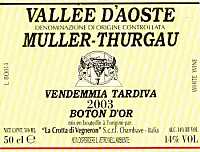
|
|
Vallée d'Aoste Müller Thurgau Vendemmia Tardiva Boton d'Or 2003 |
|
| La Crotta di Vegneron (Vallée d'Aoste, Italy) | |
| Grapes: Müller Thurgau | |
| Price: € 17.50 - 50cl | Score: |
| The wine shows a brilliant golden yellow color and nuances of golden yellow, very transparent. The nose denotes intense, clean, pleasing and refined aromas which start with hints of grape and peach followed by aromas of banana, litchi, quince, acacia honey, broom and pear. The mouth has good correspondence to the nose, a crisp attack and pleasing sweetness, however balanced by alcohol, good body, intense flavors. The finish is persistent with flavors of peach, grape and pear. | |
| Food Match: Fruit and cream desserts | |
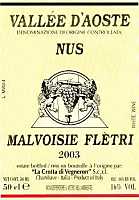
|
|
Vallée d'Aoste Nus Malvoisie Flètri 2003 |
|
| La Crotta di Vegneron (Vallée d'Aoste, Italy) | |
| Grapes: Nus Malvoisie | |
| Price: € 24.50 - 50cl | Score: |
| This wine shows a brilliant amber yellow color and nuances of golden yellow, very transparent. The nose reveals intense, clean, pleasing, refined and elegant that start with hints of raisin, honey and dried fig followed by aromas of dried apricot, peanut butter, date, quince jam, almond, lavender and vanilla. The mouth has good correspondence to the nose, a sweet attack and pleasing crispness, however balanced by alcohol, good body, intense flavors. The finish is persistent with flavors of raisin, honey, date and dried apricot. A well made wine. Nus Malvoisie Flètri ferments in cask. | |
| Food Match: Confectionery, Dried fruits desserts and tarts | |
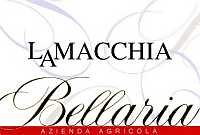
|
|
La Macchia 2000 |
|
| Bellaria (Lombardy, Italy) | |
| Grapes: Merlot | |
| Price: € 15.00 | Score: |
| The wine shows an intense ruby red color and nuances of ruby red, little transparency. The nose reveals intense, clean, pleasing and refined aromas that start with hints of black cherry, black currant and plum followed by aromas of violet, vanilla, licorice, eucalyptus, tobacco, pink pepper and cocoa. The mouth has good correspondence to the nose, a tannic attack and however balanced by alcohol, good body, intense flavors, agreeable. The finish is persistent with flavors of black cherry and plum. La Macchia ages for 24 months in barrique followed by at least 12 months of aging in bottle. | |
| Food Match: Roasted meat, Braised and stewed meat, Hard cheese | |
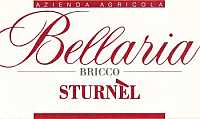
|
|
Bricco Sturnel 1999 |
|
| Bellaria (Lombardy, Italy) | |
| Grapes: Cabernet Sauvignon (80%), Barbera (20%) | |
| Price: € 15.00 | Score: |
| The wine shows an intense ruby red color and nuances of garnet red, little transparency. The nose reveals intense, clean, pleasing, refined and elegant aromas which start with hints of plum and blueberry followed by aromas of black cherry, black currant, blackberry, violet, vanilla, licorice, tobacco, carob, mace, pink pepper and menthol. The mouth has good correspondence to the nose, a tannic attack and pleasing crispness, however well balanced by alcohol, full body, intense flavors. The finish is persistent with flavors of plum and black cherry. A well made wine. Bricco Sturnel ages for 20 months in barrique followed by at least 12 months of aging in bottle. | |
| Food Match: Game, Roasted meat, Braised and stewed meat, Hard cheese | |
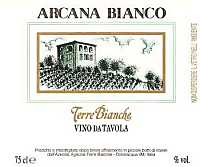
|
|
Arcana Bianco 2004 |
|
| Terre Bianche (Liguria, Italy) | |
| Grapes: Vermentino (50%), Pigato (50%) | |
| Price: € 12.50 | Score: |
| This wine shows an intense golden yellow color and nuances of straw yellow, very transparent. The nose denotes intense, clean, pleasing and refined aromas which start with hints of apple and plum followed by aromas of pineapple, hawthorn, hazelnut, honey, toasted, grapefruit and hints of rosemary. The mouth has good correspondence to the nose, a crisp attack and pleasing roundness, however balanced by alcohol, good body, intense flavors. The finish is persistent with flavors of plum, pineapple and apple. Arcana Bianco ferments and ages in barrique for 6 months. | |
| Food Match: Roasted white meat, Stuffed pasta, Roasted fish | |
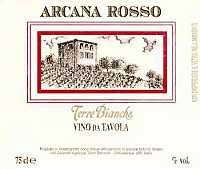
|
|
Arcana Rosso 2001 |
|
| Terre Bianche (Liguria, Italy) | |
| Grapes: Rossese (60%), Cabernet Sauvignon (40%) | |
| Price: € 15.50 | Score: |
| The wine shows an intense ruby red color and nuances of garnet red, little transparency. The nose denotes intense, clean, pleasing and refined aromas which start with hints of black cherry, plum and black currant followed by aromas of blueberry, licorice, chocolate, eucalyptus and vanilla. The mouth has good correspondence to the nose, a tannic attack and however balanced by alcohol, good body, intense flavors. The finish is persistent with flavors of black cherry, plum and black currant. Arcana Rosso ages for 12 months in barrique. | |
| Food Match: Roasted meat, Braised and stewed meat, Hard cheese | |
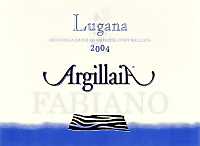
|
|
Lugana Argillaia 2004 |
|
| Fabiano (Veneto, Italy) | |
| Grapes: Trebbiano di Lugana | |
| Price: € 5.40 | Score: |
| The wine shows a pale straw yellow color and nuances of greenish yellow, very transparent. The nose denotes intense, clean and pleasing aromas which start with hints of pear, apple and almond followed by aromas of hawthorn, toasted, honey and plum. The mouth has good correspondence to the nose, a crisp attack and pleasing roundness, however balanced by alcohol, good body, intense flavors. The finish is persistent with flavors of apple and plum. A small part of this Lugana ferments in barrique. | |
| Food Match: Pasta and risotto with fish and vegetables, Broiled fish | |
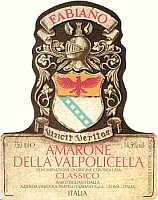
|
|
Amarone della Valpolicella Classico 2000 |
|
| Fabiano (Veneto, Italy) | |
| Grapes: Corvina (65%), Rondinella (30%), Molinara (5%) | |
| Price: € 21.60 | Score: |
| The wine shows a brilliant ruby red color and nuances of garnet red, moderate transparency. The nose reveals intense, clean, pleasing and refined aromas which start with hints of black cherry, plum and blackberry followed by aromas of violet, blueberry, vanilla, tobacco, licorice, cinnamon, cocoa and mace. The mouth has good correspondence to the nose, a tannic attack and however balanced by alcohol, full body, intense flavors, agreeable. The finish is persistent with flavors of black cherry, plum and blackberry. This Amarone ages for 3 years of which at least 10 months in cask. | |
| Food Match: Game, Roasted meat, Braised and stewed meat, Hard cheese | |
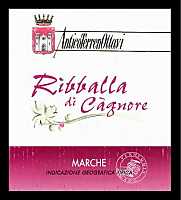
|
|
Ribballa di Cagnore 2002 |
|
| Antico Terreno Ottavi (Marches, Italy) | |
| Grapes: Montepulciano | |
| Price: € 16.00 | Score: |
| This wine shows an intense ruby red color and nuances of ruby red, little transparency. The nose denotes intense, clean, pleasing and refined aromas which start with hints of black cherry, plum and black currant followed by aromas of blueberry, licorice, cocoa, tamarind, vanilla and hints of black pepper and menthol. The mouth has good correspondence to the nose, a tannic attack and however balanced by alcohol, good body, intense flavors. The finish is persistent with flavors of black cherry, plum and black currant. This wine ages for 16-18 months in barrique. | |
| Food Match: Roasted meat, Stewed and braised meat, Hard cheese | |
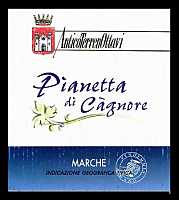
|
|
Pianetta di Cagnore Le Goduriose 2002 |
|
| Antico Terreno Ottavi (Marches, Italia) | |
| Grapes: Vernaccia Nera | |
| Price: € 20.00 | Score: |
| The wine shows a brilliant ruby red color and nuances of ruby red, little transparency. The nose reveals intense, clean, pleasing and refined aromas which start with hints of black cherry, blueberry and raspberry followed by aromas of cyclamen, plum, vanilla, licorice, tobacco, pink pepper and menthol. The mouth has good correspondence to the nose, a slightly tannic attack and however balanced by alcohol, good body, intense flavors. The finish is persistent with flavors of black cherry, raspberry and blueberry. This wine ages for 14-18 months in barrique. | |
| Food Match: Roasted meat, Stewed and braised meat with mushrooms, Hard cheese | |
RuffinoThe Tuscan company founded in 1877 is today one of the most important Italian wineries. It combines tradition and innovation, focusing on the global market, exporting its wines in more than 80 countries |
|
In 1877, in Pontassieve, few kilometers from Florence, Ilario and Leopoldo Ruffino, two Tuscan gentlemen with a great passion for their land and the great wine of Chianti hills, founded a wine company which they called with their surname. Thanks to their commitment, seriousness and to the research of quality, their winery - at the end of the nineteenth century - become one of the most famous Italian wine companies, acquiring fame abroad, too. In 1913, Ruffino was acquired by the Folonari family, which transformed Ruffino from a little company to a modern, dynamic and organized business, therefore becoming one of the most important Italian wine companies. In the course of years, Ruffino acquired estates and vineyards in the most prestigious wine areas, basing on them the success of their wines, result of continuous investments in vineyards, in cellars and in human resources.
Today, Ruffino is property of Marco and Paolo Folonari families, respectively president of Ruffino and president of Tenimenti Ruffino: brothers Luigi and Adolfo, Marco's sons, personally run the company, promoting both innovation and experimentation. Luigi is the Managing Director of the Italian market, whereas Adolfo is in charge of the same role for foreign markets. The main factors for the winery's success are: Ruffino style, that is the main role which - in the course of years - the company was capable to acquire, in relation to the evolution and the changing of wine culture; Ruffino team, that is the human resources on which the company decided to invest in order to obtain innovation and experimentation. And last, but not the least, Ruffino estates, located in the most prestigious and important wine areas. In the estates, Ruffino also produces extra virgin olive oil - although in limited quantity - of good characteristics, such as the one from Tenuta Poggio Casciano and Laudamio from Tenuta Santedame. Ruffino follows two different paths - but parallel at the same time - for viticulture and the style of their wines: the company is focused on the continuous revaluation of Tuscan traditional grape varieties, such as Sangiovese for the production of Chianti Classico, Brunello and Vino Nobile, and the rediscovery of local grape varieties, such as Colorino used in Romitorio di Santedame, a full bodied red wine, produced in Santedame estates. The company is also focused on the valuation of Tuscan wines, produced with international grape varieties, such as Cabernet Sauvignon, Merlot, Syrah, Pinot Noir and Chardonnay, which although they are cultivated in the Tuscan territory, they recently become successful in the foreign markets. From the youngest wines, easy to drink, such as Chianti Ruffino or Leo Chianti Superiore, to the wines produced in Ruffino's estates, such as Brunello di Montalcino Greppone Mazzi, Riserva Ducale Oro Chianti Classico or Romitorio di Santedame, Ruffino is capable of guaranteeing the high quality of its wide range of wines, intended to a broad target of consumers.
Ruffino's goal is the production of high quality wines, cleverly and globally distributed. The company exports in more than 80 countries, and its brand - especially known with Riserva Ducale and Riserva Ducale Oro - is now very successful. In the United States of America, Riserva Ducale Oro has become an icon wine known as Ruffino Gold Label therefore transcending its category of Chianti Classico Riserva. Since many years, the North-American market is one of the key markets for Ruffino, in particular for the so called Supertuscan wines, such as Chianti Classico, Chianti, Brunello di Montalcino and Vino Nobile di Montepulciano, as well as other IGT wines (Typical Geographic Indication, Indicazione Geografica Tipica). Ruffino's strategic choice to be present in the USA and to pursue a widespread distribution for their wines in global markets, has also been a necessity and a precise business choice in order to contrast the strong competition. To pursue these objectives, in 2004 Ruffino signed a partnership agreement with Franciscan Estates, famous Californian company being part of Constellation Brands, which owns 40% of Ruffino's company. Franciscan Estates, Ruffino's new importer, will help the Tuscan company to consolidate its leadership in the segment of Italian wines in the USA as well as to explore new markets. In Tuscany, the main Ruffino's estates are seven, for a total of 1,500 hectares, 600 of which cultivated in prestigious areas. It is important to consider Tenuta Borgo Conventi, in Friuli Venezia Giulia, located in the famous area of Collio, acquired in 2001. In Tenuta Poggio Casciano, near Florence, 62 hectares of vineyards are mainly cultivated with Sangiovese, Cabernet Sauvignon, Merlot, Syrah and Pinot Noir, a rare grape variety in Tuscany. Nero al Tondo (first released vintage has been 1985) was created in this estate, produced with 100% Pinot Noir grapes and it is considered one of the most prestigious Tuscan wines. Here is also produced Modus (first vintage released in 1997), a Supertuscan from Sangiovese, Cabernet Sauvignon and Merlot, separately vinified. Tenuta Poggio Casciano represents the heart where all Ruffino's public relations and hospitality activities take place. Tenuta di Montemasso spreads for 140 hectares, 29 of which cultivated with Sangiovese and Cabernet Sauvignon grapes. Even in this estate there is an activity of public relations. Tenuta di Santedame, in the province of Siena, spreads for 246 hectares, 70 of which partially cultivated with Sangiovese and partially with Merlot and Colorino. In 1990, Ruffino has released Romitorio di Santedame, in which it is being used Colorino grape, a rare variety in Tuscany. In the province of Siena, Tenuta Solatia spreads for 84 hectares, 44 of which cultivated with Chardonnay, 34 with Sangiovese and 6 with Pinot Gris. Here, in 1998, after a long experimentation, Chardonnay La Solatia was born. Other wines produced here include Casata, 100% Pinot Gris grapes. Gretole, in the heart of Chianti Classico territory, is an estate of 282 hectares, cultivated with Cabernet Sauvignon, Sangiovese, Merlot and Malvasia. Here it is being produced the famous Riserva Ducale Oro Chianti Classico, synonym in the world of great value Chianti. In Montepulciano, south from Siena, in the Tenuta Lodola Nuova, spreading for 159 hectares, Lodola Nuova Vino Nobile di Montepulciano and Lodola Nuova Riserva Vino Nobile di Montepulciano are being produced. In Tenuta di Greppone Mazzi, spreading for 157 hectares, in the heart of Montalcino area, are being produced: Brunello Greppone Mazzi and Brunello Riserva Greppone Mazzi, made in the best vintages only. Borgo Conventi, in Friuli Venezia Giulia, spreads for 42 hectares cultivated in the DOC areas of Collio Goriziano and Isonzo. The Borgo Conventi Collio DOC range includes Colle Russian Friulano, Sauvignon, Chardonnay, Pinot Gris, Ribolla Gialla, Merlot, Schioppettino and Braida Nuova, while “I Fiori del Bosco Isonzo DOC” range includes Chardonnay, Pinot Gris, Sauvignon, Tocai Friulano, Merlot, Refosco and Cabernet Franc.
|
||||||||||||||||||||
|
Score legend Prices are to be considered as indicative. Prices may vary according to the country or the shop where wines are bought |
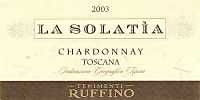
|
|
La Solatia 2003 |
|
| Ruffino (Tuscany, Italy) | |
| Grapes: Chardonnay (90%), Viognier (10%) | |
| Price: € 20.00 | Score: |
| This wine shows a pale straw yellow color and nuances of greenish yellow, very transparent. The nose reveals intense, clean, pleasing and refined aromas that start with hints of banana, acacia and vanilla followed by aromas of litchi, pineapple, pear, apple, peach, toasted and hawthorn. The mouth has good correspondence to the nose, a crisp attack and pleasing roundness, however balanced by alcohol, good body, intense flavors, agreeable. The finish is persistent with flavors of banana, pear and pineapple. La Solatia ages for 3 months in barrique followed by at least 3 months of aging in bottle. | |
| Food Match: Stuffed pasta, Fish and mushrooms soups, Broiled fish, Sauteed white meat | |
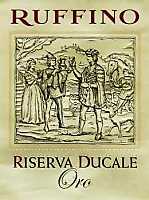
|
|
Chianti Classico Riserva Ducale Oro 2001 |
|
| Ruffino (Tuscany, Italy) | |
| Grapes: Sangiovese (85%), Colorino (10%), Merlot, Cabernet Sauvignon (5%) | |
| Price: € 22.00 | Score: |
| This Chianti Classico shows an intense ruby red color and nuances of garnet red, little transparency. The nose reveals intense, clean, pleasing and refined aromas which start with hints of plum, blueberry and black cherry followed by aromas of blackberry, violet, vanilla, licorice, carob and mace. The mouth has good correspondence to the nose, a slightly tannic attack and however balanced by alcohol, good body, intense flavors. The finish is persistent with flavors of plum and blueberry. Riserva Ducale Oro ages for 5 months in barrique followed by 28 months in cask and at least 4 months of aging in bottle. | |
| Food Match: Roasted meat, Braised meat with mushrooms, Hard cheese | |

|
|
Vino Nobile di Montepulciano Riserva Lodola Nuova 2001 |
|
| Ruffino (Tuscany, Italy) | |
| Grapes: Prugnolo Gentile (90%), Merlot (10%) | |
| Price: € 20.00 | Score: |
| This wine shows an intense ruby red color and nuances of garnet red, little transparency. The nose reveals intense, clean, pleasing, refined and elegant aromas which start with hints of black cherry and plum followed by aromas of blackberry, blueberry, raspberry, violet, vanilla, tobacco, licorice, cocoa, cinnamon, mace and menthol. The mouth has good correspondence to the nose, a tannic attack and pleasing crispness, however well balanced by alcohol, full body, intense flavors, agreeable. The finish is persistent with flavors of black cherry, plum and blueberry. A well made wine. Lodola Nuova Riserva ages for 30 months in cask followed by at least 6 months of aging in bottle. | |
| Food Match: Game, Roasted meat, Braised and stewed meat, Hard cheese | |
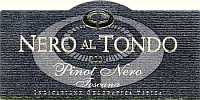
|
|
Nero al Tondo 2001 |
|
| Ruffino (Tuscany, Italy) | |
| Grapes: Pinot Noir | |
| Price: € 25.00 | Score: |
| This wine shows an intense ruby red color and nuances of garnet red, moderate transparency. The nose reveals intense, clean, pleasing, refined and elegant aromas which start with hints of cherry, plum and raspberry followed by aromas of strawberry, rose, blueberry, licorice, vanilla, tobacco, chocolate, leather, pink pepper and mace. The mouth has good correspondence to the nose, a slightly tannic attack and pleasing crispness, however well balanced by alcohol, good body, intense flavors, agreeable. The finish is persistent with flavors of cherry, raspberry and strawberry. A well made wine. Nero al Tondo ages in barrique for 12 months. | |
| Food Match: Game, Roasted meat, Stewed and braised meat | |
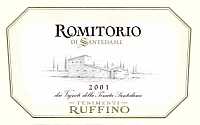
|
|
Romitorio di Santedame 2001 |
|
| Ruffino (Tuscany, Italy) | |
| Grapes: Colorino (60%), Merlot (40%) | |
| Price: € 42.00 | Score: |
| Romitorio di Santedame shows a deep ruby red color and nuances of garnet red, little transparency. The nose reveals intense, clean, pleasing, refined and elegant aromas which start with hints of cherry, plum and blueberry followed by aromas of black currant, blackberry, violet, vanilla, licorice, tobacco, cocoa, clove and menthol. The mouth has good correspondence to the nose, a tannic attack and pleasing crispness, however well balanced by alcohol, full body, intense flavors, agreeable. The finish is persistent with flavors of cherry, plum and blueberry. A well made wine. Romitorio di Santedame ages for about 18 months in barrique followed by at least 6 months of aging in bottle. | |
| Food Match: Game, Roasted meat, Braised and stewed meat, Hard cheese | |
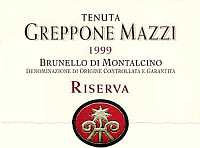
|
|
Brunello di Montalcino Riserva Greppone Mazzi 1999 |
|
| Ruffino (Tuscany, Italy) | |
| Grapes: Sangiovese | |
| Price: € 40.00 | Score: |
| This Brunello di Montalcino shows an intense ruby red color and nuances of garnet red, little transparency. The nose reveals intense, clean, pleasing, refined and elegant aromas which start with hints of plum, black cherry and raspberry followed by aromas of blueberry, blackberry, violet, vanilla, tobacco, licorice, cyclamen, carob, mace, menthol, graphite and hints of black pepper. The mouth has very good correspondence to the nose, a tannic attack and pleasing crispness, however well balanced by alcohol, full body, intense flavors, agreeable. The finish is very persistent with long flavors of plum, black cherry and raspberry. A well made wine. Greppone Mazzi Riserva ages for more than 40 months in cask followed by about 8 months of aging in bottle. | |
| Food Match: Game, Roasted meat, Braised and stewed meat, Hard cheese | |
| Ruffino - Piazzale I.L. Ruffino, 1 - 50065 Pontassieve, Florence (Italy) - Tel. +39 055 83605 Fax. +39 055 8313677 - Winemaker: Carmelo Simoncelli, Mauro Orsoni - Established: 1877 - Production: 14.000.000 bottles - E-Mail: info@tenimentiruffino.it - WEB: www.ruffino.it |
Cellar Journal |
|
This section is reserved to wine producers who want to publish news and information about their business, to announce new products or just for communicating to customers information and promotions about their products and activity. Send news to be published to our e-mail address.
|
News |
|
In this section are published news and information about events concerning the world of wine and food. Whoever is interested in publishing this kind of information can send us a mail to our address.
|
Sicilian Cooking and WineJourney in one of the most fascinating cooking of Italy, result of a story which has its roots in past ages. Delicious recipes, matched with unique wines, representing the charm of a land, rich in contrasts and colors |
|
Sicilian Cooking, among regional ones of Italy, certainly is one of the most rich IN tastes and aromas, heritage of many dominions, which took over one after another in the island. Sicilian enogastronomical tradition is in fact different in every area and is subjected to the influences of the populations, which, in past times, lived in the island. In Palermo - for example - the enogastronomical traditions are strongly linked to its history and to its past, therefore influenced by the splendor of ancient courts, around which revolved the life of the city. Dishes were rendered more elaborated in order to make a simple cuisine richer, having in the creativity of the chefs its main characteristic, which worked for viceroys and emirs. In recent times, dishes were reinvented by monsù, French chefs which worked for Bourbons, which were soon hired by local nobles. Dishes with richness in tastes, colors and smells become to emerge: caponata di melanzane (hors d'oeuvre with eggplants), frittedda (a kind of omelette) with artichokes, broad beans and peas, pasta with broccoli arriminati, timballo di anelletti (a kind of pasta shaped in little rings, especially sold in Sicily), rolls of sardines in beccafico and stuffed with sultanas, pine kernels and bread crumbs - here called muddìca - which is also the base ingredient of all the stuffing used for the dishes of Sicilian cooking.
|
|
Especially in coast areas, meat is not very used in Sicilian cooking. Make an exception to this the mountain areas and the inner villages, where mutton, meat of sheep and kid are usually eaten - especially during Easter period - and cold cuts in the Nebrodi area, in the province of Enna. In coast areas, fish has always been the main food in cooking and among the fish species, tuna fish is the most important one, frequently called “the poor's meat”. In the Egadi islands - where Favignana has become famous for “mattanza” (the final phase in tuna fish catching, in which tunas are harpooned) which takes place every year - tuna fish is vertically quartered, the way they use to do with calves, and it is then displayed in fishmonger's shops where it is being hanged upside down. In the province of Trapani, food customs are especially linked to fishing: spaghetti seasoned with tuna fish botargo - grated tuna fish eggs - are delicious. Even some vegetable dishes and caponata di melanzane are served as side dish for fish or for luteum - that is the semen of male tuna fish, made of a gelatinous mass which is boiled, served cubed like a salad or fried.
In shops selling fried food - especially in Palermo - little fried fishes, sarde a pastetta (pilchards in batter) or fried squids represent the usual snack during the day. The stands of polipari - octopus sellers - and those of sea fruits sellers represent an obligatory stop for the ones who would like to taste boiled octopus served in pieces or sea fruits, sea urchin, oysters and mussels, eaten raw, optionally with lemon juice, according to popular traditions. People from Palermo know this very well, as they usually go to Mondello, a place some kilometers away from Palermo, to taste all these delicious dishes, including sea urchins, of course during the times fishing is permitted. Pasta with the pulp of sea urchins or sepia is simply delicious. In Sicilian inland, fish is almost unknown, except for anchovies and salted sardines, an ancient bread companion, according to peasant's traditions. Makes an exception to this, la pasta con le sarde a mare (pasta with sardines left in the sea), where the sardines are actually in the sea, that is are completely absent from the recipe, which is made with fennels, anchovies, pine kernels, raisin and tomato sauce. Cous cous is also a food to be mentioned, of obvious Arab origin, which, as opposed to the one made in the Maghreb countries, is not prepared with meat but with fish only. In Sicilian tradition, cous cous is hand made by following a specific ritual: it is being kneaded, with slow circular movements, with a hand, while with the other the dough it is sprinkled with a mixture of water and salt. This operation, called incocciatura (literally to unite, putting together), is done in an earthenware bowl - mafaradda - therefore obtaining small pasta lumps - that is cous cous - which is subsequently steamed in a particular pot with holes in the bottom, called couscoussiera. At the end of cooking, cous cous is poured in a stock made of a rich sea fish soup, then it is served well puffed and grained, accompanied to the fishes used for the soup.
|
||||||||
|
In the province of Messina - important area of Byzantine, Saracenic and Norman eras - have been introduced two characteristic elements which will become traditional in cooking: rice, with which arancine are made (little rice balls stuffed with meat or ham and butter) - and by the way, never say arancini in Sicily! - as well as stockfish or piscistoccu, cooked à ghiotta, with capers, olives, tomato, onion, celery, potatoes, chili pepper, oil, salt or served raw in salad. In the cities of Catania, Syracuse and Ragusa, the way of cooking takes its origin from classical ancient times. The influences of Arab, Spanish and French people did not reach this part of the island, which remained linked to Greek sobriety and to peasant's traditions. The typical flat breads from Ragusa u pastizu, scacciate from Catania or scacce from Modica - city in the province of Ragusa and also famous for chocolate - were originally made as flat shaped breads, and with time they were then stuffed with vegetables and cheese. Enna, at the center of the cult of Ceres, goddess of the harvest, and Demeter, goddess of fertility, together with Agrigento and Caltanissetta are the cities in which peasant's traditions are stronger. Here, the relationship between man and nature is felt more, therefore creating some customs, according to a ritual of pagan origin and which was passed on till today. In Sicilian inland - where there is a large consumption of legumes and vegetables - one of the most famous soups is called maccu, a puree of dried broad beans, seasoned in different ways according to the traditions of each area: wild fennel in the province of Enna, yellow pumpkin in the area of Palermo, lentils in Petralia Sottana (a city near Palermo). When maccu gets cold, its consistency is similar to that of polenta, which is then sliced and making the peasant's lunch, as well as a hot broad beans soup makes the meal for breakfast. As for milk, being more abundant the one of sheep and notoriously containing more fat, it is usually transformed in ricotta, primosale, tuma and caciocavallo cheese. Among the cultivations introduced by Arabs, are mentioned eggplants, which since those times occupy an important place in Sicilian tables, as well as in the famous timballo, and in other tasty dishes. Peaches, apricots, delicate vegetables such as asparagus and artichokes, fragrant jasmines, spices like ginger, clove, cinnamon, saffron and then rice and carob, are all part of the Sicilian cooking. Scapece - from Spanish escabeche -is a sort of carpione of Aragonese origin, in which vegetables or fishes are first fried or grilled, then steeped in a vinegar marinade, and 'mpanata, a custard pie stuffed with vegetables, fishes or meat, similar to Spanish empanada. In the course of dominions, customs and traditions of different cultures, left evident signs in Sicilian gastronomy, which has always been receptive for new things. When Spanish introduced tomato in Europe, Sicilians were the first ones to cultivate for nutritional purposes, followed by the people of Campania region. A recent regional fashion, which then become famous in all Italy and in the rest of the world, is the cultivation of small tomatoes from Pachino (village in the province of Syracuse), main ingredient in most of the typical Sicilian recipes as well as in many Mediterranean recipes. Arabs introduced the cultivation of citrus fruits: oranges, tangerines, sweet lemons or lumie, citrons and bergamot, from which are being extracted essences with an intense aroma. Other Arab delicacies include: pistachios - famous are the ones from Bronte (in the province of Catania) - almonds, especially those from Avola (in the province of Syracuse). Other important cultivations are: prickly pears, olives, from which are produced exceptional oils, especially in the province of Trapani, from Nocellara del Belice variety. The cultivations in the island also includes grapes, such as Grillo, Catarratto, Inzolia, Damaschino, Nero d'Avola, Nerello mascalese and Nerello cappuccio.
|
||||
|
Dairy products are made with sheep and goat milks, frequently mixed together: primosale, a very young pecorino cheese, with a delicate taste and basically sweet, sometimes acid, is one of the most famous ones. The province of Ragusa, rich in pastures, is famous for the production of mozzarella cheese and especially for caciocavallo Ragusano, here known as u scalùni - literally meaning step - because of its parallelepiped shape. Bread, made in different shapes and with different mixtures, is frequently stuffed with tasty ingredients: black olives, sausage for the famous mignolata, sesame seeds for mafalda, a bread of Arab origin. An important thing to mention is a sort of pizza, which is not however a pizza, called u sfinciùni typical in Palermo. The base is like pizza dough, but the condiment is made of tomato sauce, minced onions, anchovies, primosale cheese, oregano and a little of bread crumbs - or muddìca - to be sprinkled over the condiment, before putting sfincione in the oven. Sfincione, following a tradition of the past, is still sold along the roads and in popular markets of Vucciria, Ballarò and Capo. Even today, funny men go along the streets of Palermo with a trolley, in which it is well displayed sfincione, shouting out the superb qualities of this specialty. As for Palermo, it is to be mentioned the products of rotisseries, such as arancine, calzoni, panelle (squares of fried chickpeas puree), crocchè and cazzilli, potato's croquette with parsley, fried by the “mythic” figure of panellaro (the seller of panelle). Another thing to be mentioned is u paninu ca meusa (sandwich with spleen). This is the favorite snack of many people in Palermo, especially in the center of the city: the hot spleen is used to stuff the so called pagnottella with sesame (a bun which is also used for panelle), with boiled lard and caciocavallo cheese, cut in flakes, which then melts. Other typical foods to taste in Palermo include guastedda, a sandwich stuffed with ricotta cheese, boiled lard and caciocavallo cut in flakes. In the markets and in popular quarters, especially in Palermo, it is possible to find very special food. Among the many, it is mentioned stigghiòle, a serpentine of wether's entrails, lamb, kid or calf, wrapped in long and green onions, babbaluci - or snails - especially eaten on July 15th in occasion of “Festino di Santa Rosalia” (the festivities for Rosalia Saint, patron of Palermo) and any sort of entrails and tripes. Sicilian cooking is also famous for its rich pastry, famous all over the world. Cassata, cannoli, water ices and the many almond sweets, are just some of the many examples to mention. A richness of delicacies, which would deserve a whole report.
|
|
The gastronomical richness of Sicily has a good ally in the rich selection of wines which the island can offer to the lovers of the beverage of Bacchus. White and red wines, as well as excellent fortified and sweet wines, everything seems to be perfectly made to satisfy any enogastronomical match with Sicilian cooking. Thanks to a countless recipes of fish - especially in the coast areas - many of the Sicilian red wines can be matched with this kind of cooking, frequently destined to white wines. The rich preparations with tuna fish - in particular when grilled or made with peas ragout - can be well matched to Cerasuolo di Vittoria, Nerello Mascalese and Frappato. These wines can also be matched with the rich preparations of cous cous, which can also be matched with full bodied white wines. Moreover, the rich dishes of pasta with fish, in which are used aromatic herbs and dried fruits, can be matched with red wines or with white wines having a good body, such as the ones produced with Grillo grapes. The presence of dried fruits - in Sicily used in many recipes, not only with fish - suggests the pairing with wines with a full body, with a good alcohol volume in order to balance the succulence and the unctuous taste of these ingredients. The rich cuisine “along the road” - typical in Palermo - capable of offering simple snacks as well as robust preparations - can be matched with wine. Panelle, cazzilli, crocchè and everything else the fantasy of rotisserie can create, can be matched with the typical aromatic and crisp wines of the western part of Sicily, like Alcamo and the wines produced with Catarratto and Inzolia grapes. More “robust” preparations like u paninu ca meusa and stigghiòle, can be matched very well with wines produced with the queen of Sicilian grapes: Nero d'Avola. The wines produced with Nero d'Avola grape can be used in the matching with meat, typical in the inland areas of Sicily, as well as with the generous and robust aged cheeses. Truly different considerations should be done for those dishes in which vinegar is used, such as preparations in scapece and the extraordinary and tasty caponata. In these cases, the matching with wine is pretty difficult and not advisable: the presence of vinegar generally makes wine - especially the white ones - flat and watery. In case a wine is necessary to be matched to caponata, it is advisable choosing a very smooth red wine with a good body.
|
MustardThe use of mustard is very ancient, Romans used is as a preservative, to keep fruit juices and must. French, thanks to Romans who exported it in Gaul, have become great producers and great mustard consumers |
|
The first written recipe of mustard, dated back to the fourth century b.C., talks about ground seeds with vinegar, oil and honey, however mustard is a versatile product used in many alchemies. The union of more or less strong and bitter seed, with spices, sugar, candy fruits, vinegar and must, give the birth to an universe of tastes to be explored. Mustard is a herbaceous plant, belonging to the family of Brassicacee, the same of cabbage (cruciferae). Flowers are grouped together in racemes, getting more compact during flowering, which then stretches with the ripening process. The fruit is a siliqua, supported by a long peduncle, divided in two parts: the lower part of cylindrical shape, contains round and light yellow seeds; the upper part - without seeds - has a stretched-sharped shape. All the siliquas show a rough surface, due to the presence of bristly hair.
|
|
Mustard is a plant coming from Asia, where it grows spontaneously. The first information about the cultivation of mustard are dated back to 3,000 B.C., in India, from where it was exported in the west as a precious spice: in fact, Romans and Greeks were known to commonly use mustard. Romans used it to preserve fruit juices and must, as well as eating green mustard as a cooked vegetable. Romans exported mustard to France, where it met the taste of people, becoming one of the main nations in the consumption of mustard.
Mustard was mentioned many times in the Bible. At those times, it was not used as a sauce, and its usage was limited to sprinkle broken seeds broken on foods. Only in the following period, in France, mustard is used as a sauce: seeds were crushed with honey and vinegar or mixed to grape must. It is very likely, this latter technique of preparation has given origin to the name mustard, from the Latin mustum ardens, or burning must. According to written documents, it is proved monks of Saint Germain des Près church - in Paris - were famous for the cultivation of mustard; Duke of Burgundy was famous for his parties, in which mustard was abundantly served. In 1634, producers of mustard and vinegar from Dijon obtained the exclusive right on the preparation of mustard, although they had to wear clean clothes, to keep only one shop and to brand barrels and jars with their name. Since 1937, mustard from Dijon is protected and recognized by specific French laws concerning the denomination of origin. Even today, the city of Dijon has the supremacy in production: almost half of worldwide production. In England, during the times of Shakespeare, mustard was prepared as a paste. By reading some passages of “Delights of ladies” from Sir Hugh Plat, we can understand the problems of producers and consumers of mustard at those times and why French set specific rules for the preparation of mustard. We read: «It is usual in Venice to sell the meal of mustard in their markets, as we do flour and meal in England: this meal by the addition of vinegar in two or three days becomes exceeding good mustard, but it would be much stronger and finer if the husks were first divided by sieving, which may easily be done, if you dry your seeds against the fire before you grind them. The Dutch iron handmills, or an ordinary pepper mill, may serve for this purpose. I thought it very necessary to publish this manner of making your sauce, because our mustard which we buy from the chandlers at this day, is many times made up with vile and filthy vinegar such as our stomach would abhor if we should see it before the mixing thereof with the seeds». When we talk about “mustard”, it is usually meant mustard seeds flour or the seeds themselves. The preparation based on mustard are called mustards, from the Latin mustum ardens, as many preparations make use of grape's must. The famous condiment, also called mustard, derives from two varieties of mustard: black mustard and Indian mustard, both being characterized by small, round and dark seeds. The other species - called yellow or white mustard - has larger seeds with a yellow ochre color. The particular taste of mustard is due to a glucoside, called sinagrin, in case of black mustard, or sinalbin, in case of white mustard.
|
||||||||
|
As there are many kinds of mustards, this is frequently the cause of a generalized confusion among mustard seeds and mustard sauces, including the many local recipes. Let's try to explain the differences in order to make things clear.
The hot taste of mustard is not present in the seeds of the plant and neither in the powder, but it is formed when the broken seed becomes in contact with water: only in this case a glucoside reacts with water, thanks to the action of an enzyme. The first phase in the preparation of mustard is the activation of this chemical reaction, which is very critical, because enzymes are very delicate and destroyed by hot water, inhibited by salt and vinegar. During the phase of the reaction, seeds are mixed with water, paying attention the reaction occurs correctly, allowing the seeds to rest in water for ten minutes, in order to allow the development of the essential oils. In case water is too hot, the enzyme is destroyed therefore obtaining a mild and bitter mustard, a taste caused by the non converted glucoside. When the reaction is over - that is after having obtained essential oils - the compound will be insensitive to salt and vinegar, but not to the heat, as essential oils are very volatile and can be easily lost. For this reason, in cooking mustard is always added at the end, in order to keep it “away” from the heat. Because of the fragility of this sauce, we can better understand the role of white mustard - which has not the real aroma of mustard - but stronger enzymes which are not easily damaged. Moreover, white mustard has the characteristic of keeping away mould and bacteria: this characteristic makes it a natural preservative. For this reason, white mustard is sometimes added to pickles. Another characteristic is to favor emulsion, therefore it is very useful in the preparation of mayonnaise sauce.
|
||||
|
From the eighteenth century on, all the most typical kinds of mustard were already common, the same kinds which are still today sold and consumed. English mustard. In the beginning, in England mustard was sold in powder, used for homemade preparations, by simply adding water and therefore obtaining mustard sauce. In the beginning of the eighteenth century, Mrs. Clements from Durham, invented a method which actually improved the preparation of mustard, both in the aspect as well as according to an organoleptic point of view. The success was acquired when the Royal Family gave its approval, from that moment on, Durham became the heart of mustard production. In the beginning of nineteenth century, Jeremiah Colman, a miller, fascinated by this extraordinary plant, invented a mechanized production system, and he also started a factory dedicated to the preparation of mustard. His technique consisted in finely ground mustard seeds which was subsequently sieved, dividing husks with a very fine filter made of silk, invented for this purpose. It was a real revolution in the world of mustard production, so that the name of Colman, in England, is still today the synonym of mustard. The traditional English mustard sauce is prepared with a very fine powder of black mustard, a little of white mustard and the addition of wheat flour. Wheat flour is used to improve its characteristics, absorbing part of oily substances. In some recipes, curcuma is added in order to correct color. Mustard prepared according to this recipe is called Double Superfine. Wheat flour is replaced by white mustard for people allergic to wheat. In Great Britain mustard is the traditional condiment for roast beef and ham, Welsh rarebit, as well as for fish sauces and vegetables. French mustard. French mustards (moutarde), even in case they are prepared industrially, keep traditional tastes intact, thanks to severe disciplinary of production. The main qualities of mustard used in France are two: Dijon mustard (or white mustard) and Bordeaux mustard. Dijon mustard is the most consumed in France - more than 80% - although in England, when they talk to French mustard, they refer to the one from Bordeaux, probably because this city was the main port from which French wines were exported to England and frequently wine shared the hold with mustard loads. Bordeaux mustard, of dark color because of the presence and of sweet-and-sour taste because of sugar and vinegar, is frequently flavored with herbs and spices, has a mild taste and it is used with cold meat dishes, sausages, cold cuts and vegetables. Dijon mustard has a lighter aspect - because of the absence of bran - and a marked and strong taste, although it does not have the same hotness of English mustard. Besides the mustards from Dijon and Bordeaux, in France there are other kinds of mustards: Moutarde Florida made with Champagne, Louit with the addition of red pepper, Moutarde des trois fruits rouges, so delicate and aromatic as to be put at the border of the category of mustard. Famous are also the mustards from Orleans, pretty sweet, and the one from Meaux, with a little sweet taste. German mustard. German mustard is similar to the ones from Bordeaux, shows the same dark color, has a sour-and-sweet taste and flavored with herbs and spices. German mustard can be wonderfully matched to Würstel and sausages. The heart of production of German mustard is Düsseldorf. Mustard from United States of America. It is based on the seeds of white mustard, is a pretty light mustard, which reminds spicy pickles. It is the classic mustard eaten with hot dogs. Italian mustard. Also in Italy, there are mustard preparations. The most famous one is Mostarda di Cremona. It is a spicy fruits preserve, flavored with mustard. It is served with boiled meat and cold roasts. Mostarda di Mantova is prepared using quinces, which give a sour taste.
|
|
Mustard is not used only in powder or in sauce. Mustard seeds are commonly found in pickles, in the Eastern countries they are used in the preparation of curry and in many Indian preparations mustard seeds are sauteed with ghee, exalting the sweet taste of mustard. Another product obtained from mustard seeds is mustard oil, very important in Indian and Pakistan cooking. It is produced by crushing the seeds of different species. The Indian continent produces 40% of worldwide mustard oil. Hot mustards increase gastrointestinal secretions, therefore the abuse is not advisable in order to avoid inflammations of the digestive apparatus. Mustard has also antioxidant properties. Mustards - in case they are not based on sugar, candy or syrupy fruits - can flavor dishes without adding calories. Aromas which develop during the preparation of mustard tend to disperse easily, therefore it is not advisable the purchasing of large jars. After opening, mustards must be kept in fridge, where they can stay even for a long period. French and English mustards do not contain relevant quantities of sugar and they can be kept for fews months. Italian mustards can be kept for some weeks only. Besides temperature, it should be remembered mustard does not tolerate light, which makes it darker and less tasty.
|
AquavitaeReview of Grappa, Distillates and Brandy |
|
|
| Distillates are rated according to DiWineTaste's evaluation method. Please see score legend in the "Wines of the Month" section. |

|
|
Grappa Il Pareto |
|
| Tenuta di Nozzole (Tuscany, Italy) | |
| (Distiller: Distillerie Berta) | |
| Raw matter: Pomace of Cabernet Sauvignon | |
| Price: € 20.00 - 50cl | Score: |
| The grappa is colorless, limpid and crystalline. The nose reveals intense, clean, pleasing and refined aromas of black cherry, black currant, blueberry, plum, licorice and cyclamen, with almost imperceptible alcohol pungency. In the mouth has intense flavors, with perceptible alcohol pungency which tends to dissolve rapidly, good correspondence to the nose, balanced sweet hint, pleasing roundness. The finish is persistent with flavors of black cherry, plum and blueberry. This grappa is distilled with discontinuous steam alembic still in copper boilers. Alcohol 43%. | |
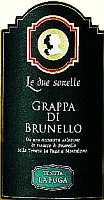
|
|
Grappa di Brunello Le Due Sorelle |
|
| Tenuta La Fuga (Tuscany, Italy) | |
| (Distiller: Distillerie Berta) | |
| Raw matter: Pomace of Sangiovese Grosso | |
| Price: € 20.00 - 50cl | Score: |
| This grappa shows a brilliant amber yellow color, limpid and crystalline. The nose reveals intense, clean, pleasing and refined aromas of prune, vanilla, licorice, black cherry, hazelnut, honey and dried fig, with almost imperceptible alcohol pungency. The mouth has intense flavors with alcohol pungency which tends to dissolve rapidly, good correspondence to the nose, balanced sweet hint, pleasing roundness. The finish is persistent with flavors of prune, honey, dried fig and hazelnut. This grappa ages in barrique and it is distilled with discontinuous steam alembic still in copper boilers. Alcohol 43%. | |
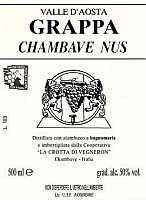
|
|
Grappa Chambave Nus |
|
| La Crotta di Vegneron (Vallée d'Aoste, Italy) | |
| Raw matter: Pomace of Chambave Rouge and Nus red grapes | |
| Price: € 15.50 - 50cl | Score: |
| This grappa is colorless, limpid and crystalline. The nose denotes intense, clean and pleasing aromas of raspberry, plum, cherry, pear and hazelnut, with almost imperceptible alcohol pungency. In the mouth has intense flavors with perceptible alcohol pungency which tends to dissolve rapidly, good correspondence to the nose, balanced sweet hint. The finish is persistent with flavors of plum and cherry. This grappa is distilled in bainmarie alembic stills. Alcohol 50%. | |
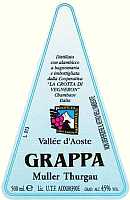
|
|
Grappa Müller Thurgau 2000 |
|
| La Crotta di Vegneron (Vallée d'Aoste, Italy) | |
| Raw matter: Pomace of Müller Thurgau | |
| Price: € 22.00 - 50cl | Score: |
| This grappa is colorless, limpid and crystalline. The nose reveals intense, clean and pleasing aromas of grape, pear, peach, banana, walnut and apple, with almost imperceptible alcohol pungency. The mouth has intense flavors with perceptible alcohol pungency which tends to dissolve rapidly, good correspondence to the nose, sweet balanced hint and pleasing roundness. The finish is persistent with flavors of grape, peach and pear. This grappa is distilled in bainmarie alembic stills. Alcohol 45%. | |
Wine Parade |
|
|
| The best 15 wines according to DiWineTaste's readers. To express your best three wines send us an E-mail or fill in the form available at our WEB site. |
| Rank | Wine, Producer | |
|---|---|---|
| 1 |
| Amarone della Valpolicella Classico 1998, Santa Sofia (Italy) |
| 2 |
| Aglianico del Vulture La Firma 2002, Cantine del Notaio (Italy) |
| 3 |
| Trento Talento Brut Riserva Methius 1998, Dorigati (Italy) |
| 4 |
| Colli Orientali del Friuli Rosazzo Bianco Terre Alte 2002, Livio Felluga (Italy) |
| 5 |
| Palazzo della Torre 2000, Allegrini (Italy) |
| 6 |
| Riesling Central Otago 2004, Felton Road (New Zealand) |
| 7 |
| Montepulciano d'Abruzzo Riparosso 2001, Illuminati (Italy) |
| 8 |
| Brunello di Montalcino 1999, Castello Banfi (Italy) |
| 9 |
| Chablis Grand Cru Les Clos 2002, Domaine Billaud-Simon (France) |
| 10 |
| Amarone della Valpolicella Classico 2000, Zenato (Italy) |
| 11 |
| Wine Obsession 2001, Vignamaggio (Italy) |
| 12 |
| Harmonium 2001, Firriato (Italy) |
| 13 |
| Rêve 2001, Velenosi Ercole (Italy) |
| 14 |
| Chianti Classico Riserva Novecento 2000, Dievole (Italy) |
| 15 |
| Notarpanaro 1999, Taurino (Italy) |
| |||||||
Privacy Policy | |||||||


| Copyright © 2002-2024 Antonello Biancalana, DiWineTaste - All rights reserved |
| All rights reserved under international copyright conventions. No part of this publication and of this WEB site may be
reproduced or utilized in any form or by any means, electronic or mechanical, without permission in writing from DiWineTaste. |